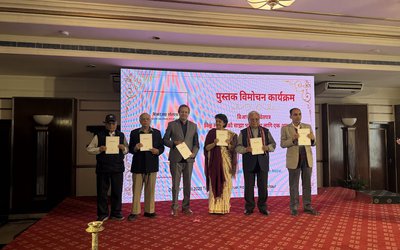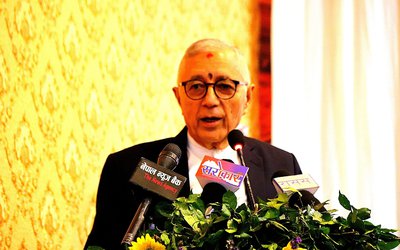The Context and Prospect for Economic Prowess
The United States has the largest consumer market, followed by China and then India. However, both India and China with large population are experiencing sustained economic growth. This could lead to increased consumer demand in future. This is important because there are potentials associated with the advantages of population dividends factor which is a significant element in determining future economic trajectories. In South-Asia countries like Bangladesh and Pakistan have also market potential due to large population if these countries were to ensure good governance and tackle corruption. The challenges for Bangladesh and Pakistan are to combat corruption for both countries are ranked high in 2022 International Corruption Perception in Index; Bangladesh is ranked at 144 and Pakistan at 140. Nepal is, with small population, ranks at 140 in this index. It is unlikely to register economic growth acceleration without expanding the consumer market-base through regional economic collaboration based on comparative advantages of economy and production and benefitting from cost-effective and efficient supply chain.
The current political rhetoric on de-coupling trading relations between the two big economies USA and China is still a long way for they are heavily dependent on each other in areas of trading. USA is a significant market for both China and India, although it is expected that they will be exploring opportunities in other parts of the world. The USA, China, and India will remain engaged between themselves for they are major players in the global market economy and due to inter-dependency in some important economic sectors, trading, information technology, for example. In 2022, trades between US-China hit a record high when US imports reached US$ 536.6 billion (6.3% higher), and export was $ 153.8 billion (1.63% higher). India’s export to China hit $ 3.51 billion during 2021 (annualized increase of 16.6%) and import was US$ 17.48 billion in 2022. Likewise, India’s export to USA was $ 76.11 billion and import was 43.31 billion.
Both Bangladesh and Nepal have seen important economic growth over the past few decades, but their growth rates have not been as high as those of China, Vietnam, or India. According to the World Bank, Bangladesh's annual GDP growth rate was 5.2% between 1980 and 2020, while Nepal's annual GDP growth rate was 4.5% during the same period. In comparison, India's annual GDP growth rate was 5.7% and China's was 9.4% during the same period. According to current data published by Visual Capitalist, China’s GDP is 19.9 trillion when India’s is US$ 3.3 trillion.
The GDP of Bangladesh in 1980 was approximately $22 billion and it figure rose to US$ 416 in 2020. Nepal’s GDP in 1980 was approximately $3 billion and it zoomed to US$ 36 billion in 2020.Bangladesh and Nepal, since 1980, have experienced economic growth and development, driven by a combination of factors. Both economiesfaced challenges emanating from political instability,corruption, misplaced economic and political quagmires and natural disasters. Nonetheless, both nations have made some progress in limited areas of their natural and comparative economic advantages. However, this situation has not resulted in reducing economic inequalities nor improving quality of life of larger population in proportion to the statistical growth.
The main drivers of Bangladesh’s GDP growth have been the expansion of the garment and textile industry, the growth of the agriculture sector, and the development of the microfinance industry. The garment and textile industry has been particularly important, accounting for around 80% of the country's total exports and employing millions of people, especially women, in the country's urban areas. In fact, Bangladesh is the second largest garment manufacturing in the world. The agriculture sector, which employs most of the country's population, has also seen significant growth due to the government's investment in irrigation, fertilizers, and seeds. At the same time, the growth of the microfinance industry has enabled small businesses and entrepreneurs to access funding and start new ventures, further contributing to the country's economic growth.
On the other hand, the main GDP drivers of Nepalcan be attributed to the development of the hydropower sector, followed by tourism industry, andexpansion of the services sector. The hydropower sector is particularly important, with the country’spotential of abundant water resources for generating significant amounts of electricityfor both domestic consumption and export. The tourism industry is equally a major contributor to Nepal's economy for employs manypeople. The services sector, like banking, telecommunications, and other related services, are also growing due to increasing demand and investment.
Bangladesh and Nepal have challenges in their efforts to sustain economic growth, including political instability, corruption, and natural disasters. However, both countries have not been able to significantly reduce the poverty levels and improve living standards for their citizens.In both countries, remittances are one of the largest sources of foreign currency and have helped to boost national GDP.Both countries have a sizable number of workers employed in the Middle East, Europe, and North America and their remittances have helped to reduce poverty, improve living standards, and boost consumer spending in the country. Remittances sent home by Bangladeshi migrant workers have been an important source of foreign currency, contributing to about 6% of the country's GDP.
Nepal is heavily reliant on remittances.It is around 30% of the country's GDP. Remittances have played a critical role in the economy because remittances have been used to finance education, health care, and housing for their families. Simultaneously, remittances have also helped to boost consumer spending, create jobs, and reduce poverty in Nepal.The other side of this phenomena of the remittance-culture is it has contributed negative impacts on the economy, such as creating a dependency on foreign currency and reducing incentives for domestic investment and innovation, and lackluster in the governance.
Consumer MarketBonanza and Asia’sFuture Growth Trajectory
China and India are the most attractive markets in the region for investors, due to their large and rapidly growing consumer markets, as well as their stable political and economic environments. Noteworthy is thatChinahas a large and growing middle class (over eight hundred million) and continues to driveforwiderspace for consumer goods and services. India is also home to a rapidly expanding middle class (around four hundred million), as well as a young and tech-savvy population that is driving growth in e-commerce and other digital industries. On the other hand, the consumer market size in China is the largest in the world, followed by India, Indonesia, Pakistan, and Bangladesh in Asia.
Bangladesh and Nepal with smaller middle-class population (Bangladesh is about fortymillionand Nepal is around sixmillion) are smaller markets with less developed economies, they offer limited potential opportunities for investors in many sectors, except in textiles and garments in Bangladesh, and hydropower and tourism in Nepal. But, again, these markets are also characterized by higher levels of political and economic instability, which can make investing more challenging.
Middle-class in South-Asia has expanded rapidly in recent years. In fact, Asian market is growing, and it is expected to reach at 3.5 billion by 2030 according to World Economic Forum. By then, this region, lead by ASEAN, China, and India, will be the driving force of the global economy that is led by Asia’sgrowing middle-class. This can be attributed to factors like growing urbanization, education, and rising incomes, economic diversifications in most Asian countries.
South-Asian Diaspora Community and KnowledgeEconomy
A knowledge-based economy is still the bedrock of world economy for it was this domain that broke trade barriers and changed the business environment with the start of online influential e-commerce marketplaces started by Amazon and eBay. It rapidly grew and transformed the trading landscape globally. The knowledge economy, characterized by the production, distribution, and use of knowledge and information, has played a crucial role in shaping the global economy. In recent years, there has been a significant shift towards knowledge-based industries, which include digital technology, software, biotechnology, and other knowledge-intensive sectors.
The United States and China currently hold dominance in knowledge economy, with both countries being home to some of the world's largest digital companies and knowledge-based firms. However, other countries such as Japan, South Korea, Germany, and Israel also have significant knowledge economies and knowledge-based industries. The biggest knowledge companies in the world like Apple, Amazon, Alphabet/Google, Microsoft, Meta/Facebookare highly influential and have a significant impact on innovation, job creation, and economic growth.
Among the diaspora community, the Indian diaspora is well-represented in the technology industry, with prominent Indian American entrepreneurs and executives leading some of the world's largest tech companies. According to Forbes' Billionaires list from 2021, there are currently eleven billionaires from India living in the United States. Apart from American companies hiring Indians directly from India, multi-nationalIndian IT companies like TATA, Infosys, Wipro, Tech Mahindra, Cognizant, HCL Tech create 80,000 jobs in the USA. Average income of Indian household in US earns an average of US$ 123,700 per year, which is double the national average, according to US Census data.
Chinese, Indian, and Filipino descent are the largest and most influential Asian diaspora communities in the USA. Some of the wealthiest diaspora communities in the US include those of Indian, Chinese, and Jewish descent. The Jewish diaspora in the USAis one of the wealthiest and most influential communities, with prominent business leaders, entrepreneurs, and philanthropists.In recent years, in political arena, descendants of South-Asians have made remarkable ascendancy into the positions of Prime Minister of the United Kingdom, Republic of Ireland, First Minister of Scotland and Vice-President in the USA.
The presence of Chinese and Indian diasporascommunities has a notable presence in theeconomy. According to a report by the Migration Policy Institute, in 2015, there were approximately 2.6 million people of Chinese descent and 2.4 million people of Indian descent in the US. The Chinese and Indian diasporas have been able to impact some economic influences in their countries of origin through remittances, investments, and business connections. It is yet to be noticed high impact as economic driver played by Nepali and Bangladeshi diaspora in the USA and in the country of origin if compared with other diaspora community in the USA andlack influence in political arena.
Nepali diaspora members are smaller than other diasporas and highly educated are engaged in academia and research fields, but notably most are employed in blue-color jobs in diverse field such as malls, care providers and retail businesses. According to the Migration Policy Institute, the Nepalese community is only about 160,000 individuals in 2019. Some Nepali community organizations, however, claim that this figure is between 200 to 350,000, but it is smaller than other South-Asian diaspora communities in the USA.
Increasingly influential Indian American diaspora are engaged in the political economy of the US, with many prominent Indian Americans serving in the US government, civil servants, including elected officials, political appointees, and other influential positions. Indian Americans are also engaged in political positions, fundraising, campaign contributions, and advocacy on various issues. According to a report by the Indian American Impact Fund, there are currently over two hundred Indian Americans holding elected or appointed positions at the federal, state, and local levels of government in the USA.Most Importantly, the new president of the World Bank Group is a first Indian immigrant who assumed the highest position in June 2023.
It is worth noting that Asian diaspora community is highly educated and occupy a wide range of professional positions. For instance, Indians in the United States are often over-represented in Science Technology Engineering Mathematics (STEM) fields, including software development, engineering, and technology. Chinese diasporais also involved in a wide range of fields, including technology, finance, and academia. Bangladeshi and Nepali communities are smaller in comparison to others and less visible at the national level. There is long way for other South Asians to become important players in the Western Hemisphere, but opportunities exist for future.
Kedar Neupane is a board member of Nepal Policy Institute, an independent international think-tank, and a retiree United Nations staff. Observations, views, and comments expressed in this piece are the author’s personal. Neupanek1950@gmail.com

Kedar Neupane
He can be reached at Neupanek1950@gmail.com
- Talking About Growth Miracle And Emerging Quadripolar Economic Construct (Part – Two)
- Jul 28, 2023
- Talking About Growth Miracle and Emerging Quadripolar Economic Construct (Part – One)
- Jul 02, 2023
- Pseudo-Nationalism Is About Political Desperation And Sure Sign of Economic Collapse Context And Background
- Jun 19, 2023
- Realities In Conflict Of Interest And Challenges Of Combating Corruption In Nepal: PART -TWO
- Jun 08, 2023
- Realities In Conflict Of Interest And Challenges Of Combating Corruption In Nepal
- May 13, 2023














